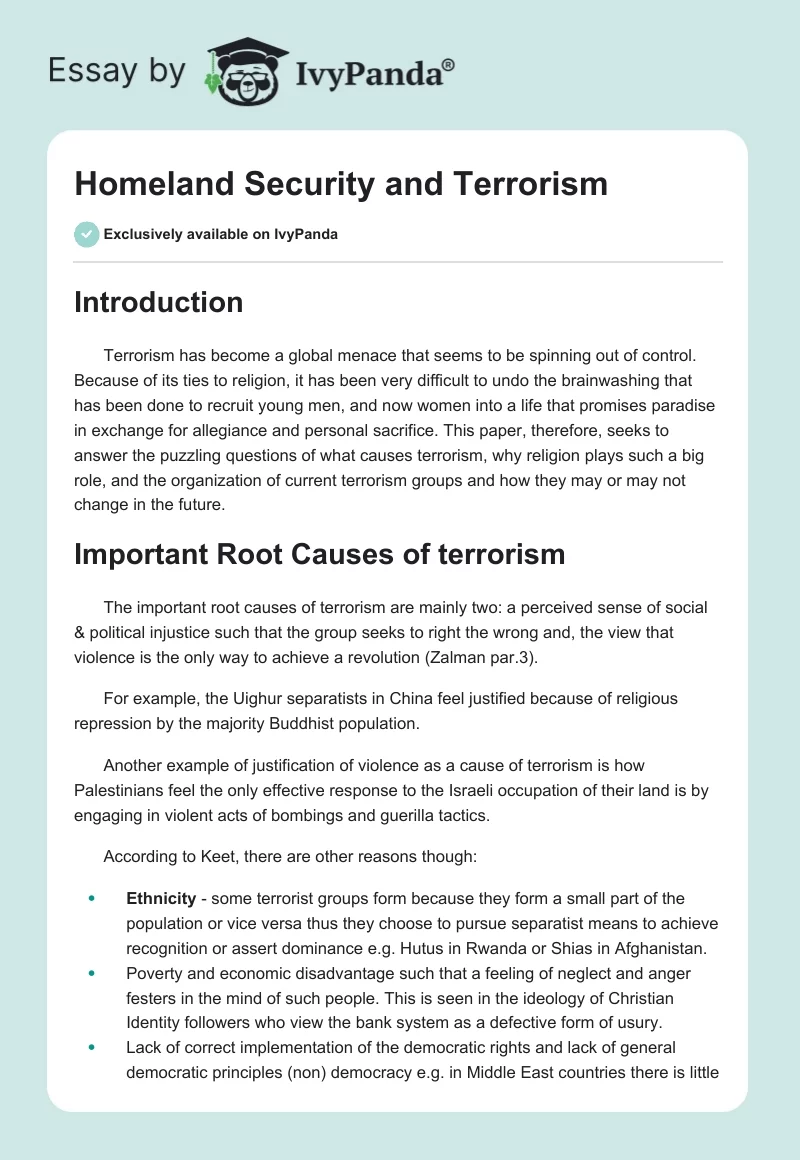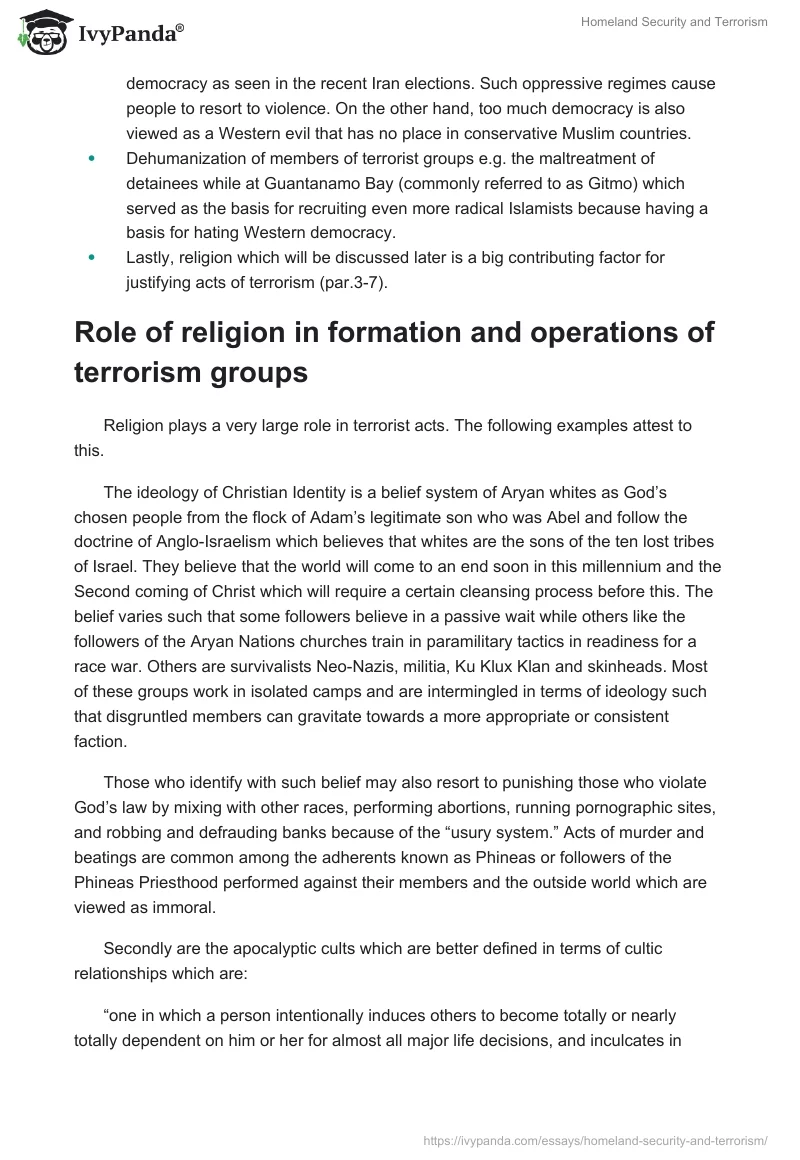Introduction
Terrorism has become a global menace that seems to be spinning out of control. Because of its ties to religion, it has been very difficult to undo the brainwashing that has been done to recruit young men, and now women into a life that promises paradise in exchange for allegiance and personal sacrifice. This paper, therefore, seeks to answer the puzzling questions of what causes terrorism, why religion plays such a big role, and the organization of current terrorism groups and how they may or may not change in the future.
Important Root Causes of terrorism
The important root causes of terrorism are mainly two: a perceived sense of social & political injustice such that the group seeks to right the wrong and, the view that violence is the only way to achieve a revolution (Zalman par.3).
For example, the Uighur separatists in China feel justified because of religious repression by the majority Buddhist population.
Another example of justification of violence as a cause of terrorism is how Palestinians feel the only effective response to the Israeli occupation of their land is by engaging in violent acts of bombings and guerilla tactics.
According to Keet, there are other reasons though:
- Ethnicity – some terrorist groups form because they form a small part of the population or vice versa thus they choose to pursue separatist means to achieve recognition or assert dominance e.g. Hutus in Rwanda or Shias in Afghanistan.
- Poverty and economic disadvantage such that a feeling of neglect and anger festers in the mind of such people. This is seen in the ideology of Christian Identity followers who view the bank system as a defective form of usury.
- Lack of correct implementation of the democratic rights and lack of general democratic principles (non) democracy e.g. in Middle East countries there is little democracy as seen in the recent Iran elections. Such oppressive regimes cause people to resort to violence. On the other hand, too much democracy is also viewed as a Western evil that has no place in conservative Muslim countries.
- Dehumanization of members of terrorist groups e.g. the maltreatment of detainees while at Guantanamo Bay (commonly referred to as Gitmo) which served as the basis for recruiting even more radical Islamists because having a basis for hating Western democracy.
- Lastly, religion which will be discussed later is a big contributing factor for justifying acts of terrorism (par.3-7).
Role of religion in formation and operations of terrorism groups
Religion plays a very large role in terrorist acts. The following examples attest to this.
The ideology of Christian Identity is a belief system of Aryan whites as God’s chosen people from the flock of Adam’s legitimate son who was Abel and follow the doctrine of Anglo-Israelism which believes that whites are the sons of the ten lost tribes of Israel. They believe that the world will come to an end soon in this millennium and the Second coming of Christ which will require a certain cleansing process before this. The belief varies such that some followers believe in a passive wait while others like the followers of the Aryan Nations churches train in paramilitary tactics in readiness for a race war. Others are survivalists Neo-Nazis, militia, Ku Klux Klan and skinheads. Most of these groups work in isolated camps and are intermingled in terms of ideology such that disgruntled members can gravitate towards a more appropriate or consistent faction.
Those who identify with such belief may also resort to punishing those who violate God’s law by mixing with other races, performing abortions, running pornographic sites, and robbing and defrauding banks because of the “usury system.” Acts of murder and beatings are common among the adherents known as Phineas or followers of the Phineas Priesthood performed against their members and the outside world which are viewed as immoral.
Secondly are the apocalyptic cults which are better defined in terms of cultic relationships which are:
“one in which a person intentionally induces others to become totally or nearly totally dependent on him or her for almost all major life decisions, and inculcates in these followers a belief that he or she has some special talent, gift, or knowledge”(FBI par.19).
Cultic tendencies for violence can be classified into 2: defensive violence where the members resort to aggression to protect their enclave from outside influence e.g. in Waco, Texas under a branch of the Davidian complex.
In the view of these cults, violent acts will hasten the prophecies about Armageddon and the coming of the Messiah. For example Jewish religious zealots are willing to destroy the sacred Al-Aqsa mosque or the Dome of Rocks and rebuild Jewish temples as a pre-requisite to the coming of the Messiah.
Religion to terrorists is, in summary, a way of obtaining redemption, sending symbolic messages as well a form of social mobilization. It provides an organizational network in places of worship through which religious leaders can spread the message. Lastly, it provides moral justification for violence.
Major Organizational structures of terrorist groups and how they may or may not change in the future
Finally, we shall look at the organizational patterns of current terrorism groups.
There are 3 categories of organization of terrorist groups: cellular, networked and hierarchical.
Cellular groups are usually those that operate in terrorist cells. They may be multifunctional or specialized. The cells rarely know other cells that are working in the same organization to ensure the whole group is not compromised in case of capture.
The networked organization is characteristic of newer groups and involves coordinating or networking with international branches. Hierarchical organization is based on a chain of command is more common in politically motivated groups.
According to Juergensmeyer “religion is a desperation that comes in response to deep frustration” ( 8).
These groups could in the future become even more strengthened by the innovation of social networking sites like Twitter and Facebook which connect more and more people and offer a platform for inculcating radical ideas.
However, according to Juergensmeyer “the religious passions of activists can vanish as quickly as they appear”(10). With time such groups lose public support and appeal and people realize that there are alternative ways to achieve their goals. The situation in Northern Ireland is a case in point of dissipation of terrorists and violent ideology.
Conclusion
In conclusion, this paper has discussed the various causes of terrorism which include religion, dehumanization, poverty, social & political injustice, (non) democracy, ethnicity, and the view that violence is the effector of change. Also, the role of religion is discussed as a way of organizing groups, providing moral justification, spiritual redemption, and social mobilization. The current organization of groups into hierarchical, cellular, and networked sums up the ideas postulated in this paper with insight into how these organizations may or may not change in the future. Will they become more radical because of globalization and the use of social networking sites or will they blow off all their steam and dissipate into a painful and historical memory of tumultuous times in our recent history.
Works Cited
FBI. Christian Identity, Apocalyptic Cults and Significance of Jerusalem. FB I Reports, n.d. Print.
Juergensmeyer, Mark. From Bhindrawale to Bin Laden: The rise of Religious Violence. University of California, 2004. Print.
Keet, Marijke. Causes of Terrorism. Meteck, 2005.Web.
Zalman, Amy. The Causes of T errorism.About.com, 2010. Web.


